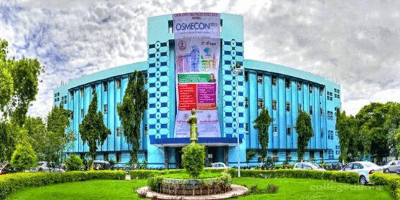
Osmania Medical College: Established 1846
Osmania Medical College (former known as Hyderabad Medical School) was the first medical school started in Nizam’s state of Hyderabad in year 1846. The medium of education was in Urdu language and the degree was called Hakeem.
In 1919 when Osmania University was established by Seventh and the last Nizam of Hyderabad Nawab Mir Osman Ali Khan, and in the following year, 1920 Hyderabad Medical School became Osmania Medical College.
History of Osmania Medical College, Hyderabad (History by Year)
- 1846: Hyderabad Medical School Instituted by NAWAB NASIRUD – DOULA
- Dr. MACLEAN – First Principal,
- Diploma Awardee “HAKEEM”
- Five Year Course Urdu Medium
- 1985: Medium of Instruction changed to English by Surgeon MAJOR EDWARD LAWRIE
- 1985: Hyderabad Medical School attained Worldwide Fame
- 1989: Because of Chloroform Commission
- 1976: Hospital & Medical School were constructed in the Present Premises of Osmania General Hospital – Now as, Afzalgunj Hospital.
- 1908: Afzalgunj Hospital Collapsed due to Musi Floods.
- 1920: The Hyderabad Medical School became Osmania Medical College, after establishing Osmania University in 1919.
- 1925: The Present Osmania General Hospital Built by OSMAN ALI – KHAN. The Seventh Nizam.
- 1926: MBBS Course Started in URDU Medium.
- 1948: Medium of Instruction changed to English
- 1962: The Present College Building Commissioned.
Academic Strength:
- 200 : No. of MBBS admission Per Year
- 274 : No. of Post Graduate Admission per year
- 42 : No. of Super Specialty admission per year
- 21 : No. of Post Graduate Courses
- 10 : No. of Teaching Hospitals attached to OMC:
- 4897 : No. of Teaching Beds
- 141 : No. of Professors
- 87 : No. of Associate Professor
- 239 : No. of Asst. Professors Tutors CAS.
- 35,700: No. of Books in Library
- 441 : No. of inmates a: Boys
- 468 : In the Hostels b: girls
- 20 Acre: Total area of the college
- With College Guest house and College
Affiliation
Affiliated to N TR Health University
Departments of Osmania Medical College:
Anatomy Department, Biochemistry Department, Physiology Department, Pharmacology Department, Pathology Department, Microbiology Department, Forensic Medicine, ENT Department, Ophthalmology, Community Medicine, Internal Medicine, Surgery Department, Plastic Surgery, Gynecology and Obstetrics (Nayapool), Gynecology and Obstetrics (Niloufer Hospital), Gynecology and Obstetrics (Sultan Bazar Hospital), Orthopedics Department, Dermatology Department, Cardiology Department, Neurology Department, TB and Chest Hospital and Anesthesia Department.

Gandhi Medical College: Established 1851
Gandhi Hospital was started in 1851, Gandhi hospital was stared initially as an Infirmary of 3 wards, formed into a Cantonment Hospital with 95 beds faclities in 1900.
Later in 1913, it was progressed to King Edward Memorial Hospital and after the Independence of India, in 1954 become Gandhi Medical College with teaching facilities with 1200 beds, and later in 1956, it was recognized by the Medical Council of India.
Departments of Gandhi Medical College:
Anatomy, Anesthesia, Biochemistry, Blood Bank, Cardiology, Cardio-Thoracic Surgery, Casualty, Community Medicine, Dental, Dermatology, Endocrinology, ENT, Forensic Medicine, Gastroenterology, General Medicine, General Surgery, Hospital Administration, Microbiology, Nephrology, Neurology, Neurosurgery, Gynecology and Obstetrics, Ophthalmology, Orthopedics, Pathology, Pediatric Surgery, Pediatrics, Pharmacology, Physiology, Plastic Surgery, Psychiatry, Radiology, Urology, TB&CD, ART, ICTC, Medical Records, STD, Emergency, OPD, Transport and Respiratory Medicine
Gandhi Medical College Hospital Units and Beds Facilities
- Dept. Gen. Medicine, 7 Units, 210 Beds.
- Dept. Pediatrics, 4 Units, 120 Beds.
- Dept. TB & Respiratory Medicine, 1 Unit, 30 beds.
- Dept. Psychiatry, 1 Unit, 30 beds.
- Dept. Dermatology, 1 Unit, 30 beds.
- Dept. Gen. Surgery, 7 Units, 230 Beds.
- Dept. Orthopedics, 4 Units, 120 Beds.
- Dept. Ophthalmology, 2 Units, 60 Beds.
- Dept. ENT, 1 Unit, 30 Beds and
- Dept. OBG, 4 Units, 120 Beds.
GMC Post Graduate Diploma Available Seat
- Diploma in Anesthesia, 6 Seat
- Diploma in Child Health, 4 Seats
- Diploma in Clinical Pathology, 2 Seats
- Diploma in Gynecology, 10 Seats
- Diploma in Oto-Rhino-Laryngology, 2 Seats
- Diploma in Radio-Diagnosis, 1 Seat
- Diploma in Ophthalmology, 1 Seat
- Diploma in Public Health, 1 Seat
- Diploma in DDVL, 3 Seats
GMC Post Graduate Available Seat
- MD in Anesthesiology, 10 Seats
- MD in Anatomy, 4 Seats
- MD in Bio Chemist, 4 Seats
- MD in Forensic Medicine, 5 Seats
- MD in General Medicine, 12 Seats.
- MD in Microbiology, 4 Seats
- MD in OBG, 10 Seats
- MD in Pediatrics, 5 Seats
- MD in Pathology, 8 Seats
- MD in DVL, 3 Seats
- MD in Pharmacology, 4 Seats
- MD in Physiology, 2 Seats
- MD in Radio Diagnosis, 3 Seats
- MD in Community Medicine, 2 Seats
- MD in TB & CD, 2 Seats
- MS in Orthopedics, 6 Seats
- MS in General Surgery, 14 Seats,
- MS in Ophthalmology, 4 Seats
- MS in Psychiatry, I Seat
GMC Super Specialty Seats
- Department of Urology, 2 Seats
- Department of Neurology, 2 Seats
- Department of Neurosurgery, 2 Seats
- Department of Cardiology, 3 Seats
- Department of CT Surgery, 1 Seat
- Department of Nephrology, 3 Seats
- Department of Gastroenterology. 3 Seats
- Department of Plastic Surgery, 3 Seats
- Department of Endocrinology, 2 Seats
- Department of Pediatric Surgery, 1 Seat
